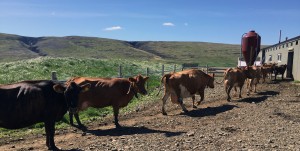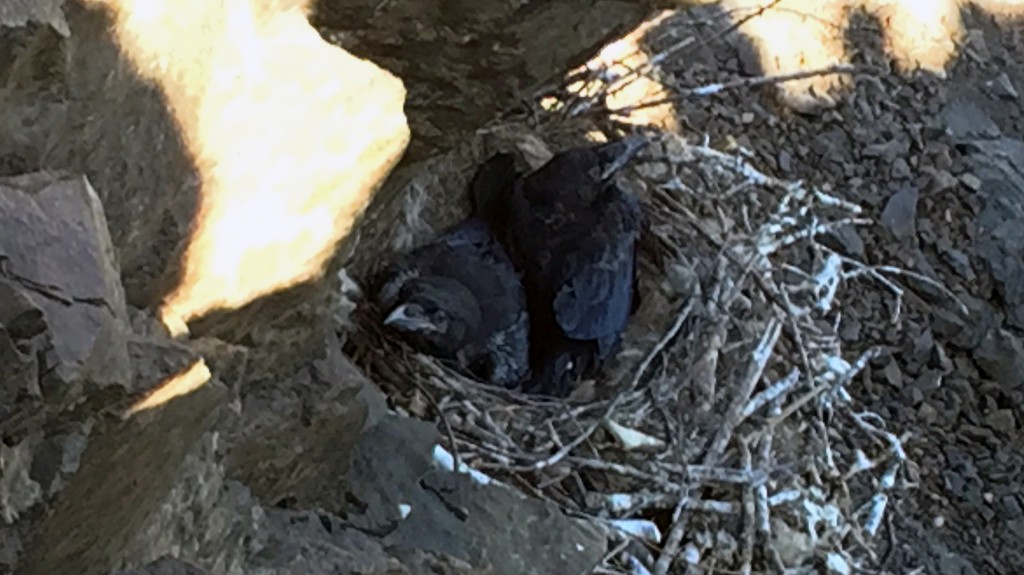Today’s highlights were climbing a volcano, visiting a dairy farm, and seeing the Viking home of Erik the Red.
On the way we stopped at a farm field to see drainage ditches dug into soil. Dr. Slater explained that the water table in Iceland is high due to snow melting from the mountains and glaciers. These ditches have environmental repercussions if done all over Iceland because groundwater runs into sea. This dries out the dirt and oxidizes iron. Also, the glaciers are receding, and Dr. Slater said Iceland is projected to be ice free by 2100. What will that be like? A lot of the clean drinking water comes from the glaciers. Even the hot springs business we saw relies on glacier melt.
We then drove over a beautiful bridge over the glacial river Hvita, which means White River. The farm behind river gets cut off by flooding. Although this was a narrow road and one-lane bridge, it was the main thoroughfare between north and south Iceland.
At another stop we saw a raven’s nest in an old quarry. I got some pictures of the raven chicks and of some different kinds of flowers.
Climbing Grabrok
Then we arrived at the Grabrok volcano. I am not good at stair steps up, and these steps were endless. However, I have wanted to see inside a volcano since I was a kid. I watched everyone else go up and debated whether to go. Finally I decided that the first set of steps did not look that bad, and I could take breaks, so I set off.
With a few breaks to catch my breath, I made it up the flight of steps visible from the ground fairly well — but little did I know that when I rounded the corner, there would be another long flight of steps! I debated going back down, but I had come this far, so after a short rest I started up those steps too. Unfortunately the hand rail stopped about halfway up the second flight. Again I thought about going back, but when I turned around and looked down, I started to get dizzy. Clearly going down was going to be harder than going up. So back up I went.
Finally I arrived at the first crater. I could see into it and got some pictures — basically it was a bunch of hardened lava rocks inside. I’m not sure what else I expected — had it been molten lava, it would not be open for the public to see. It was still pretty cool. However, to see into the second crater required climbing up yet another set of steps with no handrail and walking around the edge of the one I had just climbed. I didn’t think I would be up for that and sat on the bench.
At that point some of the other students (Danielle, Thomas, and Mitch) stopped by and asked how I was doing. They had already been up on the edge and gone all the way around. They said the view was amazing. I said I probably couldn’t do it. Danielle then offered to let me take her arm, and she would guide me up and around. I hesitated at first because I’ve never been in a position where I needed physical help, especially from someone I barely know. But it was such a kind offer, and without it, I really wasn’t sure I would be able to get down without getting dizzy and risking a fall. So I accepted, and we were able to walk around the entire crater, see the second crater, and get a view of the town below.
The crater lip was wider than I thought, which helped, and I was able to hold Danielle’s arm most of the way down. Thomas accompanied us as well, and we were all able to talk and bond while touring. On the way down we stopped at what looked like an archaeological site near the volcano and got some more photos. Finally we made it down to the bus, and I was very happy that I had decided to give it a try at the bottom, even though I had no idea at the time just how many steps it involved. Had I known, I might not have gone, so maybe it was good that about two-thirds of the steps were hidden from view.
On the way to the next stop we saw the landmark Mount Baula. It looks like a triangle of rock coming out of the earth. Dr. Slater said it was made of rhyolite and other volcanic leftovers pushed above the earth. We also saw endless numbers of waterfalls on the side of mountains. Dr. Slater pointed out that Icelanders were trying to reforest by planting trees, but that it’s a little controversial. Iceland used to be covered with trees, but people had cut them all down through the centuries. Now the hillsides were being planted with conifers and birch, but not all the trees are native to Iceland, hence the controversy.
Personally I am not sure why that is so important. Climate change is threatening the existence of humans and every other species, and reforestation is a big part of the solution for sequestering carbon. We must do reforestation. Certainly we should plant native trees because those are most likely to thrive. But if other species of trees also thrive, why not plant them too? Variety leads to healthier stock and more genetic diversity gives resistance to disease. The main thing is to get trees planted to help with absorbing all the excess carbon in the atmosphere.
Dairy farm
The next stop was the Erpsstadir dairy farm. We heard a talk from its owner, Thorgrimur Einar Gudbjartsson — a really interesting guy. The farm milks 60 cows a day, considered pretty large for Iceland, and produces 85 to 90 calves a year. Cows deliver their first calf at 2 years old, and start by milking 10 liters in the morning and 7 in the afternoon. That amount increases each day and peaks at two months. Once the cow is pregnant again, milk production goes down until it stops six weeks before the next birth. Calves are left with their mothers in the barn for 100 days. The males are raised for two years before being sold for meat. The females are raised to replace the milking herd or sold for meat.
The cows are housed in the barn in winter but get access to fresh pasture on nearby mountains all summer. They are very happy to hit the fields at the start of spring. The farm keeps two bulls for breeding, and sometimes they are released in the same area as the cow herd to do their thing. The cows can live a long time with this kind of life. The oldest cow on the farm was born in 2001. She was the first to come in to be milked when the farmer opened the fence to let the cows into the barn. The breed is simply called Icelandic — a mix of breeds brought by settlers 1100 years ago.
Milking is done robotically. The cows step into the milking area one by one, then the sensor figures out where to clean the teats and milk the cow. The cows are generally anxious to get into the milking area to be relieved of the pressure in their udders. The cows have access to the milking area 24/7. If there is a problem, the machine will call Gudbjartsson no matter the time of day or night.
In 2008, the farm expanded into the agrotourism business, building a sales and reception area. They finished just before the financial crash. They sell teas, skyr, and lots of ice cream. The other students each tried an ice cream but I opted to buy some skyr. It tasted a little like very thick buttermilk, heavy and full of protein and probiotics.
Erpsstadir is named after one of first settlers in Iceland. When the house and barn were first built in 1985, archaeologists found ruins from some of the earliest settlements in Iceland. This area is a good climate for agriculture, and farming has gone on here for 12,000 years.
Erik the Red’s home
The next stop was Eirikstaddir, a reconstruction of the home of Erik the Red. We listened to a talk by a costumed guide and got to try out some Viking equipment. Erik was from Norway, known for his big red hair and beard, and seemed to get into constant trouble. At one point, a neighbor killed two of his sheep, so he killed neighbor’s two sons and was expelled from valley.
Erik’s house was made of driftwood and constructed so that all the pieces fit together with no nails, so he could take it apart and take with him wherever he went. When he was expelled, he headed to the Westman Islands, but gave his household items to a friend to keep. Unfortunately the friend would not give the items back, so Erik killed friend and his son too. That got him expelled from Iceland for three years — if anyone found him, they could legally kill him.
At that point Erik packed up his house and went to Greenland. All he found was snow and ice, rocks, sea, and nothing green. But he named it Greenland in an attempt to get more settlers to come thinking it would be a good place to farm. This is often seen as the world’s first marketing ploy.
Erik also sent his own son, Leif Erikson, to the king of Norway to learn how to be a farmer. When Leif sailed back in 998, he overshot Greenland and ended up on the coast of Canada. Unlike Greenland, Canada was actually green, so Leif settled there for a few years. He then rented his house to Europeans and went back to Greenland where he was made head of state. Erik died in Greenland in 1005 to 1010. By then 1,000 Europeans had settled on the southwest coast. Leif died in Greenland in 1030.
After seeing Erik’s house, we got a late lunch, then headed to Seljaland to stay at a farm with guest cabins. This area was the home of Tobba’s grandparents, so close to her heart. She led the group on a “one-hour” hike, while I stayed in the room to catch up on some sleep and call home. Two hours later everyone was back and exhausted from hiking almost straight uphill. We got an excellent and much-needed dinner and headed to bed.
Here are some more photos from the day. Click on any photo to enlarge it.
- Raven chicks in a nest on the cliff of an old quarry.
- The second crater at Grabrok.
- Thomas enjoying the lava ruins at the foot of Grabrok.
- Mt. Baula is made of rhyolite.
- Lunch time.
- Farm piggies playing.











